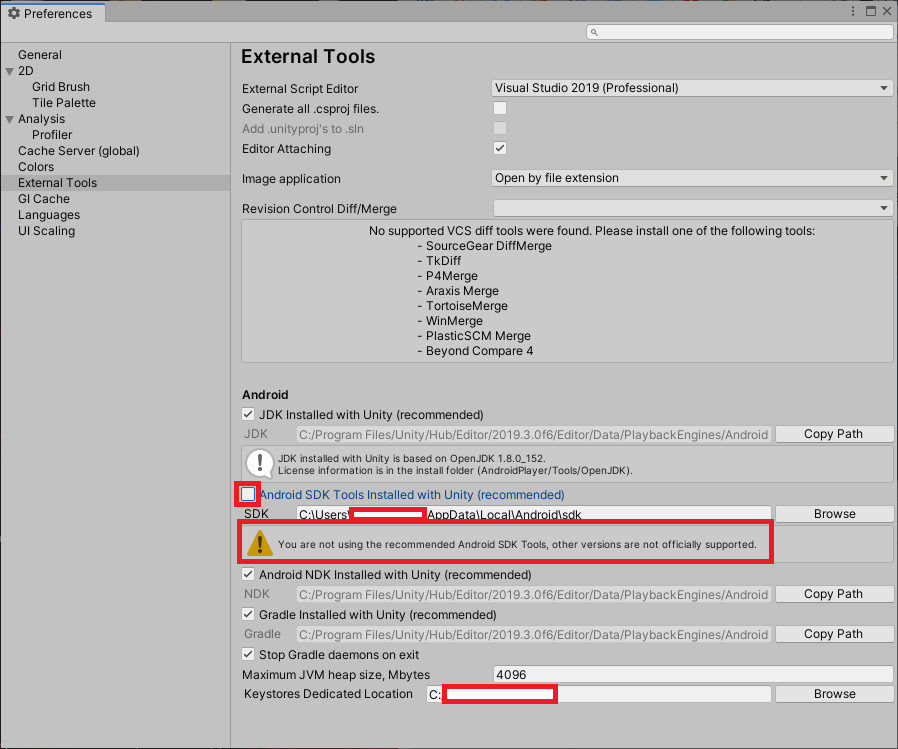

- #UNITY ANDROID NDK INSTALL#
- #UNITY ANDROID NDK UPDATE#
- #UNITY ANDROID NDK ARCHIVE#
- #UNITY ANDROID NDK FULL#
- #UNITY ANDROID NDK WINDOWS 10#
Vuforia Engine for the Android platform is accessible through a C API.

#UNITY ANDROID NDK FULL#
Samples\ // Sample applications with full source code The pattern xx-yy-zz stands for the version number of Vuforia Engine.
#UNITY ANDROID NDK ARCHIVE#
The extracted SDK archive will create the following directory structure in the vuforia-sdk-android- folder. This enables the SDK to be updated without the need to modify your source tree. To streamline development, we have defined a directory structure that maintains Vuforia Engine and your applications in separate directory trees. This structure ensures that Vuforia Engine sample apps can easily be built and deployed using the Android SDK, Android NDK, and the Android Studio development environment.
As a convention, we will refer to the root directory of your Vuforia Engine for Android development environment as DEVELOPMENT_ROOTĮxtracting the SDK will create a directory structure for your Android development environment. C:\Development\Android on Windows, or /Users//Development/Android on OSX or Linux) Extract the contents of the SDK ZIP archive, placing it in your Android development root folder (e.g. To start developing with the Vuforia Engine SDK: Vuforia Engine is distributed as a ZIP package for the following platforms: Installing Vuforia Engine for Android Clean installation If you use bash shell, add the following to ~/.bashrc : export PATH=$PATH:/opt/android-sdk/tools:/opt/android-sdk/platform-tools Linux: Update your PATH to point to the Android SDK Platform-tools directory. Mac OSX: Update the PATH variable to point to the Android SDK Platform-tools directory in the /etc/rc.common file or ~/.bash_profile: export PATH=$PATH:~/Development/Android/android-sdk/tools:~/Development/Android/android-sdk/platform-tools NOTE: The last "\" at the end of the Path variable must be included. In the above example, you would add:Ĭ:\Development\Android\android-sdk\tools\ C:\Development\Android\android-sdk\platform-tools\ Add the full path to the directory at the end of the path, separated by a semicolon from the previous path. After pressing Edit, scroll to the end of Variable value: and add New variable. Under the Advanced tab, select Environment Variables and select Variable Path in the System variables window. Click the Advanced system settings button to open the System Properties window. In the File Explorer, right-click This PC and select Properties. If you have chosen a different folder directory than the default, it is necessary to add those directories to your Windows Path: If you plan to work outside of Android Studio and use tools like adb directly, you will need to manually configure Environment Variables on your system for Android development. Do not exit the SDK Manager or it will cancel the download. NOTE: the downloads progress is shown at the bottom of the SDK Manager window. #UNITY ANDROID NDK INSTALL#
Once you have selected all the desired packages, continue to click install and accept the license agreements.
 Android API matching that of your own Android device. Android SDK Platform-Tools (latest rev.). In the dialog window that opens, set Android SDK Location to C:\Development\Android\android-sdk. In the Welcome to Android Studio, click on Configure and select SDK Manager or in Android Studio, click on the SDK Manager icon in the Toolbar. We recommend running the SDK Manager after the installation of Android Studio, in order to download the necessary components for developing with Vuforia Engine.
Android API matching that of your own Android device. Android SDK Platform-Tools (latest rev.). In the dialog window that opens, set Android SDK Location to C:\Development\Android\android-sdk. In the Welcome to Android Studio, click on Configure and select SDK Manager or in Android Studio, click on the SDK Manager icon in the Toolbar. We recommend running the SDK Manager after the installation of Android Studio, in order to download the necessary components for developing with Vuforia Engine. #UNITY ANDROID NDK UPDATE#
See the Android SDK Packages section.Īndroid Studio includes a SDK manager that allows you to install additional SDK components, besides the ones installed with Android Studio, and to update your Android SDK tools. In order to develop in Android Studio with C++, install the Android NDK from the SDK Manager. To set up the development environment, install these components in the following order, using the latest versions of the tools with Vuforia Engine: Vuforia Engine requires the Android SDK and the Android NDK for C++ development. If you have already set up the Android SDK and NDK, go directly to Installing Vuforia Engine for Android.
#UNITY ANDROID NDK WINDOWS 10#
NOTE: This setup guide was written for the Windows 10 64-bit platform with special notes for other operating systems. The permission ensures the Vuforia Engine can retrieve sensor data from Android devices using VISLAM. NOTE: For Vuforia projects targeting Android API level 31 or above, you should make sure to add the permission _SAMPLING_RATE_SENSORS to the manifest.xml file. Please refer to the Vuforia Engine Supported Versions page for details on the latest supported versions of Android and Android tools such as Android Studio. Setting Up the Android Development Environment







 0 kommentar(er)
0 kommentar(er)
